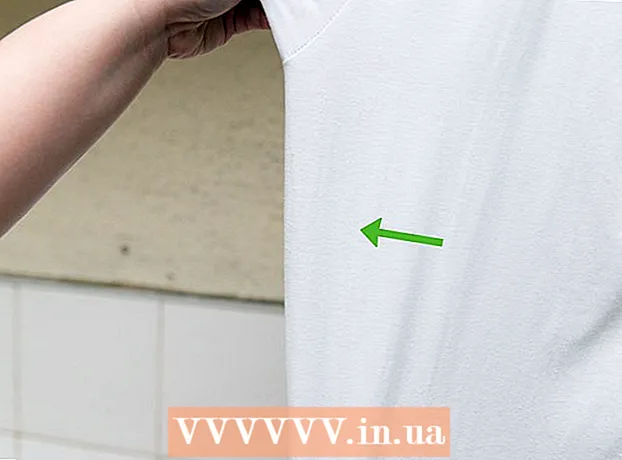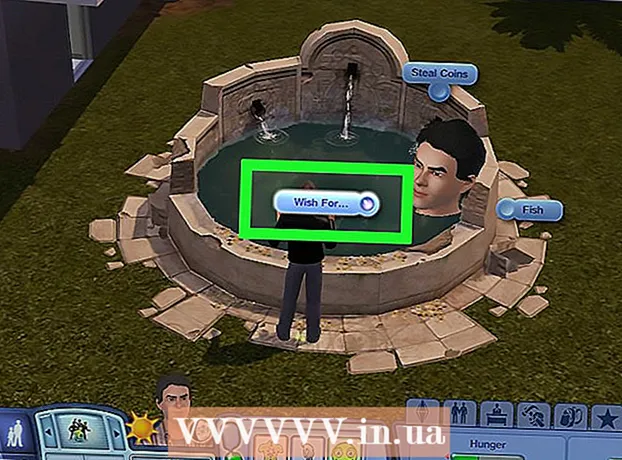Author:
Florence Bailey
Date Of Creation:
27 March 2021
Update Date:
1 July 2024

Content
- Steps
- Method 1 of 2: Connecting an HDMI device
- Method 2 of 2: Connecting a non-HDMI device to the HDMI jack on the TV
- Tips
This article will show you how to connect various video devices such as computers, cameras, and game systems to the HDMI port on your TV. HDMI (High Definition Multimedia Interface) is a popular interface for transferring high definition digital audio and video between devices. Even if the device does not have an HDMI port, the connection can be made using a special cable or adapter.
Steps
Method 1 of 2: Connecting an HDMI device
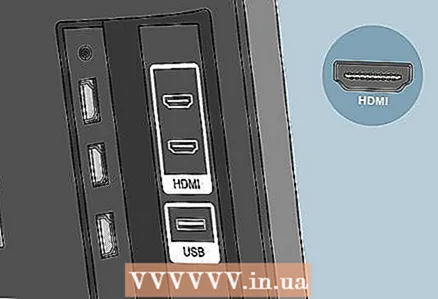 1 Find a free HDMI port on your TV. Most modern TVs have at least one full-size (Type A) HDMI connector, which measures 13.9mm x 4.45mm. This connector is commonly referred to as “HDMI”. If the device has multiple ports, each of them will be numbered (for example, HDMI 1, HDMI 2).
1 Find a free HDMI port on your TV. Most modern TVs have at least one full-size (Type A) HDMI connector, which measures 13.9mm x 4.45mm. This connector is commonly referred to as “HDMI”. If the device has multiple ports, each of them will be numbered (for example, HDMI 1, HDMI 2). - On some TVs, HDMI connectors can also be found on the front or side panel.
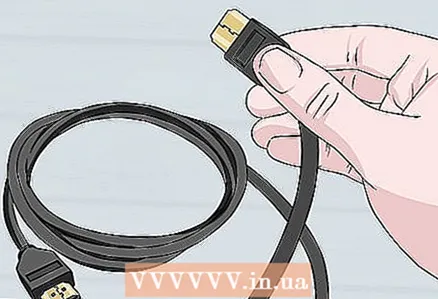 2 Get the right HDMI cable. If the HDMI ports on your device and your TV are the same size (Type A / 13.99mm x 4.45mm), use a standard HDMI Type A cable with the same 19-pin connectors on both ends. At the same time, some devices (usually cameras and portable media players) have smaller HDMI connectors, which may cause you to need a different type of cable:
2 Get the right HDMI cable. If the HDMI ports on your device and your TV are the same size (Type A / 13.99mm x 4.45mm), use a standard HDMI Type A cable with the same 19-pin connectors on both ends. At the same time, some devices (usually cameras and portable media players) have smaller HDMI connectors, which may cause you to need a different type of cable: - Type C / Mini-HDMI: this type of HDMI connector is commonly found on older digital cameras and camcorders. It measures 10.42mm x 2.42mm, which is significantly smaller than Type A. If your device has this connector, you will need a Mini HDMI to HDMI cable.
- Type D / Micro-HDMI: even smaller than Type C. This 6.4mm x 2.8mm connector is commonly used on small recording devices such as GoPro and some smartphones. You will need a Micro HDMI to HDMI cable to connect to it.
 3 Connect one end of the cable to the device. Turn on the device you want to connect to the TV, and then gently insert the appropriate end of the cable into its HDMI connector.
3 Connect one end of the cable to the device. Turn on the device you want to connect to the TV, and then gently insert the appropriate end of the cable into its HDMI connector. - HDMI cable connectors can only be inserted in one direction. Never try to force the cable connector into the connector, as this may damage not only the cable, but also the device itself.
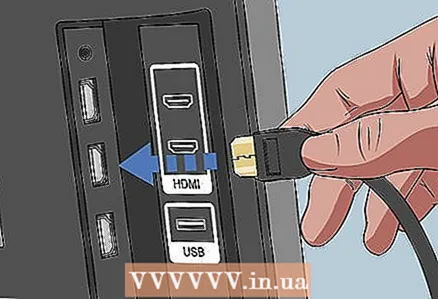 4 Connect the other end of the cable to your TV. Turn on the TV and then plug the cable into it. If your TV has multiple HDMI sockets, remember the number of the one you are using.
4 Connect the other end of the cable to your TV. Turn on the TV and then plug the cable into it. If your TV has multiple HDMI sockets, remember the number of the one you are using.  5 Switch the TV to HDMI source. Use the "SOURCE" or "INPUT" button on the TV or remote control to select the HDMI port. You will most likely have to press the button several times before you reach the desired connector. When you switch to the correct signal source, a picture of the device will appear on the screen.
5 Switch the TV to HDMI source. Use the "SOURCE" or "INPUT" button on the TV or remote control to select the HDMI port. You will most likely have to press the button several times before you reach the desired connector. When you switch to the correct signal source, a picture of the device will appear on the screen. - If you have a Windows computer, click ⊞ Win+Pto open the Project panel, and then switch to broadcasting the image on your TV. If you want to display the desktop, select the Duplicate option.
- If you have a Mac, the screen should automatically appear on your TV screen. If the picture on the TV is not at the correct resolution, go to Apple menu> System Preferences> Monitors> Monitor and select "Default for Monitor". If you want to use a specific resolution, select "Scaling" and choose the appropriate resolution.
 6 Set up audio from your computer to your TV (optional). If you've connected your computer to a TV and want to get sound through the TV's speakers, follow these steps:
6 Set up audio from your computer to your TV (optional). If you've connected your computer to a TV and want to get sound through the TV's speakers, follow these steps: - Mac: go to Apple menu> System Preferences> Sound> Output and select TV or HDMI port as output device.
- Windows: right-click the volume icon in the taskbar (next to the clock), select Volume Options, and from the Sound Devices menu, select the default playback device. Typically this should be “Speakers” (High Definition Audio).
Method 2 of 2: Connecting a non-HDMI device to the HDMI jack on the TV
 1 Look for an HDMI-compatible connector on the device. If your TV has an HDMI connector but your game console, computer, or other device doesn't have one, use an adapter that converts your current connector to a standard HDMI connector (Type A). HDMI adapters / cables are available for the following connector types:
1 Look for an HDMI-compatible connector on the device. If your TV has an HDMI connector but your game console, computer, or other device doesn't have one, use an adapter that converts your current connector to a standard HDMI connector (Type A). HDMI adapters / cables are available for the following connector types: - DisplayPort: when converted to HDMI, this connector supports both digital audio and high definition video. Find the ports labeled "DP" or "DisplayPort". If your laptop or tablet has DisplayPort, you'll need a DisplayPort to HDMI cable or adapter.
- Some devices, including the Microsoft Surface, have DisplayPort Mini instead of the standard DisplayPort connector. In this case, you will need a DisplayPort Mini to HDMI cable or adapter.
- DVI: DVI connectors do not carry audio, but they do allow high quality video to be transmitted through a DVI to HDMI cable or adapter. Note that DVI connectors come in different sizes, so make sure you select the correct cable. Count the number of pins in the DVI connector and compare with the available cables and adapters.
- VGA: if the device has an outdated VGA port, you will not only have to be content with the deterioration of the picture quality on the TV, but also the lack of sound. Nevertheless, this will not deprive you of the opportunity to connect the device via a VGA-HDMI adapter.
- DisplayPort: when converted to HDMI, this connector supports both digital audio and high definition video. Find the ports labeled "DP" or "DisplayPort". If your laptop or tablet has DisplayPort, you'll need a DisplayPort to HDMI cable or adapter.
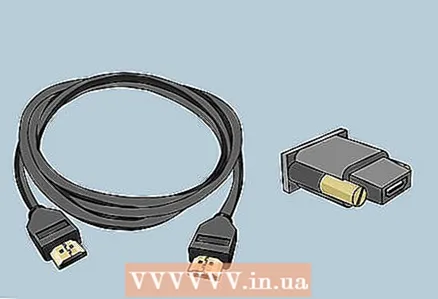 2 Choose the correct cable or adapter.
2 Choose the correct cable or adapter.- Most modern TVs will have at least one full-size (Type A) HDMI connector, which measures 13.9mm x 4.45mm. The most common cables are those with an HDMI connector on one side and a DVI, DisplayPort, or VGA connector on the other. The main thing is to make sure that the size of the connectors matches the connectors on the device.
- An alternative is to purchase a small adapter. With the adapter, you will need to connect a standard HDMI cable to the HDMI connector and a standard DVI, DisplayPort, or VGA cable to the corresponding connector on the other side. In other words, you will need two different types of cables connected to the same adapter.
- The HDMI cable must also be long enough to reach the TV from the device. Choose a cable slightly longer than necessary to minimize cable strain between devices.
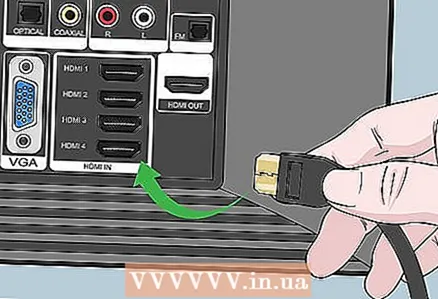 3 Connect the HDMI-A connector to the jack on your TV. Turn on the TV and then fix the cable securely. If your TV has multiple HDMI sockets, remember the number of the one you are using.
3 Connect the HDMI-A connector to the jack on your TV. Turn on the TV and then fix the cable securely. If your TV has multiple HDMI sockets, remember the number of the one you are using.  4 Connect the other end of the cable to your device or adapter. If you have an HDMI to (other interface) cable, connect the appropriate connector to this jack. If you bought an adapter, connect the other side of the HDMI cable to the HDMI connector of the adapter, and already connect it to the device via the appropriate cable (DVI, DisplayPort, or VGA) for that device.
4 Connect the other end of the cable to your device or adapter. If you have an HDMI to (other interface) cable, connect the appropriate connector to this jack. If you bought an adapter, connect the other side of the HDMI cable to the HDMI connector of the adapter, and already connect it to the device via the appropriate cable (DVI, DisplayPort, or VGA) for that device. - Do not try to force the cable connector into the connector. It can only be inserted one way, and if the connector does not fit, you probably have the wrong cable.
- If you are using a VGA adapter, connect each connector on the adapter to the corresponding audio and video ports on your computer based on their color.
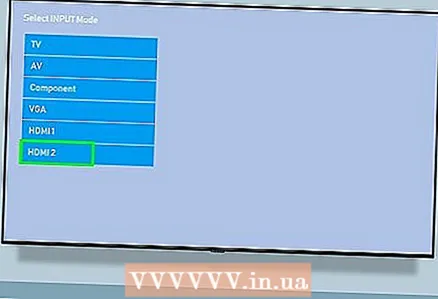 5 Switch the TV to HDMI source. First turn on the device that does not have an HDMI jack, and then use the “SOURCE” or “INPUT” button on the TV or remote control to select the HDMI port. You will most likely have to press the button several times before you get to the desired signal. When you switch to the correct signal source, a picture of the device will appear on the screen.
5 Switch the TV to HDMI source. First turn on the device that does not have an HDMI jack, and then use the “SOURCE” or “INPUT” button on the TV or remote control to select the HDMI port. You will most likely have to press the button several times before you get to the desired signal. When you switch to the correct signal source, a picture of the device will appear on the screen. - If you have a Windows computer, click ⊞ Win+Pto open the Project panel, and then switch to broadcasting the image on your TV. If you want to display the desktop, select the Duplicate option.
- If you have a Mac, the screen should automatically appear on your TV screen. If the picture on the TV is not at the correct resolution, go to Apple menu> System Preferences> Monitors> Monitor and select "Default for Monitor". If you want to use a specific resolution, select "Scaling" and choose the appropriate resolution.
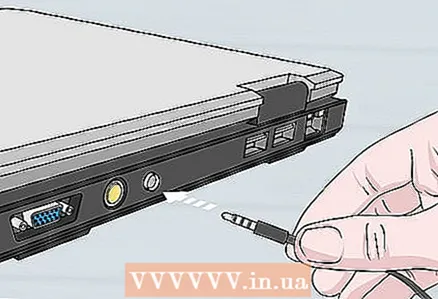 6 Connect the audio cable separately if necessary. If the connection was not via DisplayPort, use a separate audio cable for the TV.
6 Connect the audio cable separately if necessary. If the connection was not via DisplayPort, use a separate audio cable for the TV. - If the input device and TV have the correct ports, connect the two devices directly with a separate stereo cable.
- In addition, the audio cable can be used to transfer sound from the input device to separate speakers connected to the TV.
Tips
- If you cannot see the picture on the TV, check the connector and / or connector for dirt and corrosion. If cleaning does not work, try using a lubricant for electrical contacts. Apply just a little grease to the contacts and wipe off any excess so that the contacts do not short-circuit.
- Don't even think about buying an expensive HDMI cable. Since the transmitted signal is digital, it will either work or not, and the difference in quality between expensive and inexpensive cable is negligible.
- Note that you may need an amplifier or active cable to carry 1080p signals over 7.5m or 1080i signals over 15m. In either case, you will need an external power source, as well as a free outlet for it.

